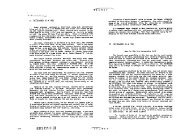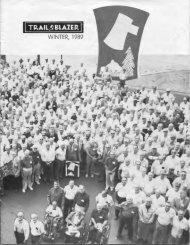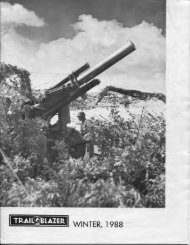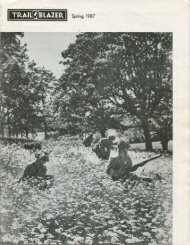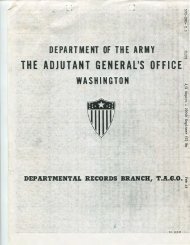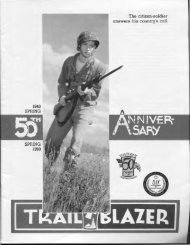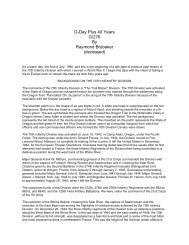History Part 1 - 70th Infantry Division Association
History Part 1 - 70th Infantry Division Association
History Part 1 - 70th Infantry Division Association
You also want an ePaper? Increase the reach of your titles
YUMPU automatically turns print PDFs into web optimized ePapers that Google loves.
ftlonech<br />
ZM friendly fog which did not liftuntil the sun was at its mid-day height<br />
covered the initialstages of the attack on the 14th of March. When night fell on the<br />
day following all enemy along the Group front were either captured or destroyed.<br />
More than fifty per cent of all easualdties were the result of sniper fire. Each and<br />
every house had to be cleared. This was a first success and while the men were fully<br />
aware of the determined fighting character of their enemy they now stood firmin the<br />
knowledge that they had beaten him and could do so again and again ... and didt<br />
St. Ingbert Is Captured<br />
Swinging to the right, these units met their next test in the fighting before the<br />
Siegfried Line. Some of the best young leaders and troopers paid for the ground<br />
gained at this point. The dueling of artillery was nothing short of terrific with the<br />
friendly guns (thankfully) having the upper hand. Finally, the Combat Engineers cut<br />
and blew their way through baribed wire entanglements and rows ofconcrete "Dragon's<br />
Teeth". The initial taste of actual Mechanized Cavalry action was now at hand as<br />
was the first deep run into enemy held territory. Passing through the "hole" in the<br />
outercrust of the line, elements of the Group struck out through miles of narrow<br />
valley roads dominated by great frowning pillboxes which for some unknown reason<br />
were unmanned. Thus the Siegfried Line was penetrated throughout its entire depth<br />
and tifb town of St. Ingbert was captured for the 63rd <strong>Division</strong> to which the Group<br />
Was attached at the time.<br />
Crossing Of The Rhine<br />
Returning to direct control of the XXI Corps, to which it had been recently<br />
reassigned, the Group moved into the Hartz Mountains where several days were spent<br />
profitably in mopping up scattered groups of enemy who were seeking to escape over<br />
the mountain trails. On the move again and through the vineyards of the Rhine Valley<br />
all elements of the Group crossed the famous river via a ponton bridge at Worms<br />
on the "second day" and moved into the beautiful Odenwald country which gave<br />
birth to the legends made internationally famous through the great musical works of<br />
Richard Wagner. Here the fighting became determined and, from village to village,<br />
and town to town, the Group pounded its way forward steadily.<br />
17



